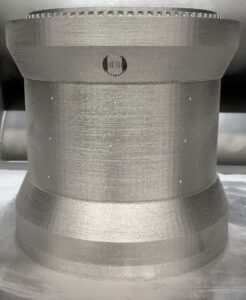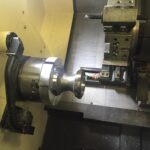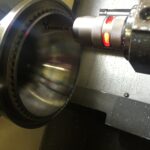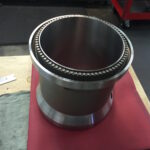MTI To Sponsor SEDS of UCSD | Aerospace Additive Manufacturing
November 3, 2015MTI To Display At 2015 Defense Manufacturing Conference
November 17, 2015MTI Utilizes Aerospace Additive Manufacturing Expertise In NASA Partnership
Metal Technology (MTI) is collaborating with NASA Johnson Space Center (JSC) to develop the next generation of rocket engines through aerospace additive manufacturing.
Few organizations are as busy integrating 3D metal printing into their engineering and design work as NASA. NASA currently has multiple business units working their own projects as part of an effort to leverage best practices using digital manufacturing methods, including 3D metal Printing.
Teams of propulsion engineers and scientists are working to integrate new features or join individual parts through the use of aerospace additive manufacturing methods. Features such as conformal channels for regenerative cooling or other geometry not constrained by traditional manufacturing techniques holds the promise of increasing performance and/or reducing weight. Additionally, total part count-reduction can have a significant economic impact on total cost.
cost.
The Future Of Space Exploration Rests With Aerospace Additive Manufacturing
Additive manufacturing (3D printing) has a clear business case for space flight development. As such, MTI has embraced the technology and are now being called upon to produce first-article test components for the customers they have served with traditional manufacturing techniques for over thirty years.
MTI has produced two such components for the engineering team at NASA JSC out of Inconel 718. The material is robust enough to withstand extreme heat and corrosive environments without losing its rigidity or becoming brittle.
“The Project provided amazing dialogue and collaboration between the NASA and MTI development teams and the results were excellent” said Gary Cosmer, Chief Executive Officer for MTI.
The collaborating efforts yielded components that will need to withstand temperatures well above the melting point of the material. This, of course, would be impossible without engineered cooling. That’s where aerospace additive manufacturing shines. Recirculating gases can be channeled throughout the component by invisible channels that are literally built into the component, 60 micron layers at a time.
Keeping in mind that the end game is to reduce cost and weight while increasing performance, these targets are important milestones for NASA as it reaches out further into space.
MTI is no stranger to space related projects and has produced forgings for the Orion capsule, which is likely the platform to travel upon NASA’s new launch vehicle, the SLS – Space Launch System. The Orion, SLS package will be used to take man to Mars for the first time. Maybe MTI will have printed parts of the primary launch system for those missions as well. That’s the plan.
About Metal Technology (MTI)
With more than forty years of experience applying innovative, proprietary technologies, Metal Technology (MTI) is making possible the use of difficult alloys for a wider range of applications with greater efficiency, versatility, and reliability. Alloys include Tantalum, Niobium, Zirconium, Titanium, Tungsten and Molybdenum. MTI uses specialized deep-draw, spinning, forging, machining, EDM, and additive manufacturing methods to deliver superior products according to your exacting specifications.
Contact us for more information on our aerospace additive manufacturing initiatives.




